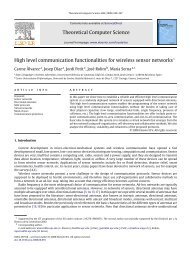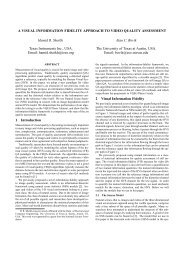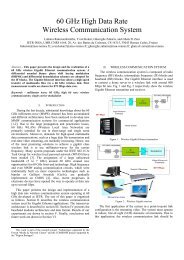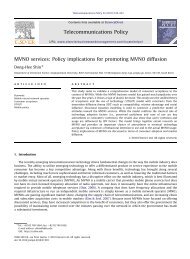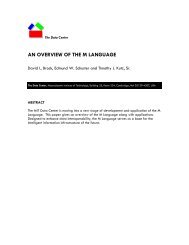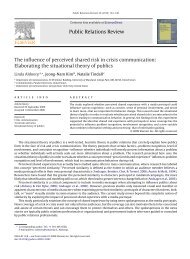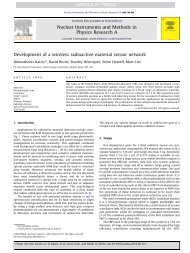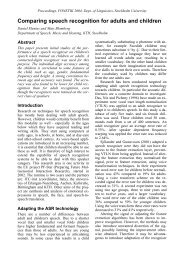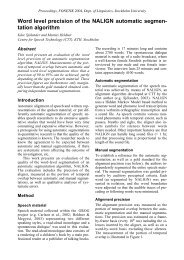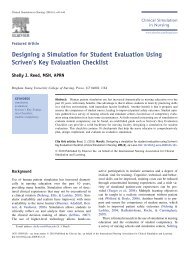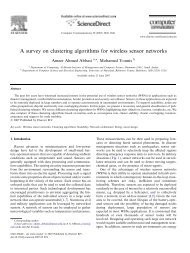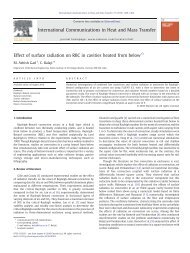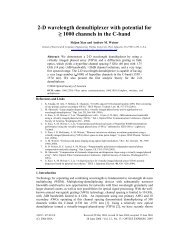BLR: beacon-less routing algorithm for mobile ad hoc networks
BLR: beacon-less routing algorithm for mobile ad hoc networks
BLR: beacon-less routing algorithm for mobile ad hoc networks
You also want an ePaper? Increase the reach of your titles
YUMPU automatically turns print PDFs into web optimized ePapers that Google loves.
1082<br />
Fig. 4. Number of hops vs. node density.<br />
has neverthe<strong>less</strong> a strong impact on the number of hops.<br />
With n ¼ 80; the number of successful hops with the circle<br />
as <strong>for</strong>warding area is about twice and five times as high as<br />
<strong>for</strong> the Reuleaux triangle and sector, respectively. The<br />
absolute and relative difference between the three <strong>for</strong>warding<br />
areas is even increasing <strong>for</strong> denser <strong>networks</strong>. In Fig. 5,<br />
the number of expected successful hops EðYÞ is shown on a<br />
logarithmic y-axis depending on the node density n and<br />
transmission r<strong>ad</strong>ius r <strong>for</strong> the sector as <strong>for</strong>warding area. It can<br />
be observed that the transmission range has a major<br />
influence. For small transmission ranges of 100 m, the<br />
greedy mode fails only after a few hops even <strong>for</strong> high node<br />
densities. Completely unlike in the case <strong>for</strong> r ¼ 1000 m, the<br />
number of successful hops increases very strongly with only<br />
a minor increase of the node density. These conclusions<br />
apply as well to the other <strong>for</strong>warding areas, not depicted<br />
here.<br />
The results are similar to the observation m<strong>ad</strong>e in Ref.<br />
[44] where the connectivity of a wire<strong>less</strong> network depending<br />
on the node density was considered. The network stays<br />
disconnected <strong>for</strong> node densities below a certain threshold<br />
Fig. 5. Number of hops vs. node density.<br />
M. Heissenbüttel et al. / Computer Communications 27 (2004) 1076–1086<br />
Fig. 6. Normalized <strong>for</strong>warding areas.<br />
and almost gets completely connected <strong>for</strong> values over that<br />
threshold.<br />
4.2. Expected progress in a sector<br />
In order to be able to calculate, e.g. the average delay per<br />
hop introduced by the <strong>algorithm</strong>, not only the Poisson<br />
distribution of the number of nodes of Eq. (4) has to be taken<br />
into account, but also the distribution of the location of the<br />
‘best’ node, i.e. the node that computes the shortest DFD.<br />
This is due to the fact that if the number of nodes within the<br />
<strong>for</strong>warding area is larger than 1, only the node with the<br />
minimum introduced <strong>ad</strong>ditional delay relays the packet any<br />
further.<br />
Since all <strong>for</strong>warding areas are symmetrical along the line<br />
in the direction of the destination, we may consider only the<br />
upper half and assume that the transmission range is scaled<br />
to 1 without loss of generality (cp. Fig. 6). (For simplicity<br />
reasons and due to lack of space, we explicitly derive here<br />
only the functions <strong>for</strong> the sector and the delay function (1).<br />
See Ref. [45] <strong>for</strong> a more detailed derivation and <strong>ad</strong>ditional<br />
results.)<br />
The density function <strong>for</strong> the progress X of one node<br />
located within the sector is given by f ðxÞ; which describes<br />
the border of the <strong>for</strong>warding area as depicted in Fig. 6.<br />
1<br />
pffiffi3 x : 0 # x #<br />
f ðxÞ ¼<br />
3 8<br />
pffiffi<br />
><<br />
p<br />
rffiffiffiffiffiffiffiffiffiffiffi<br />
rffiffiffiffi<br />
12 3 12<br />
2 x2 : p ffiffip , x #<br />
p p<br />
>:<br />
0 : otherwise<br />
By integration, this yields the distribution function FX: 0 :<br />
1<br />
2<br />
FXðtÞ¼ t , 0<br />
ffiffi 3<br />
p t2 : 0 # t # 3 rffiffiffiffiffiffiffiffiffiffi<br />
t 12<br />
2 t2 :<br />
2 p<br />
þ<br />
pffiffi<br />
p<br />
6<br />
p arcsin<br />
ffiffiffiffiffi<br />
p<br />
12 t<br />
8<br />
><<br />
r<br />
2 2 :<br />
>: 1 :<br />
rffiffiffiffi<br />
3 12<br />
p ffiffip , t #<br />
p<br />
rffiffiffiffi<br />
12<br />
t .<br />
p<br />
ð6Þ


